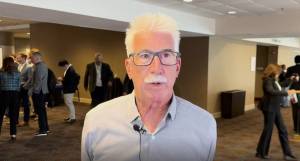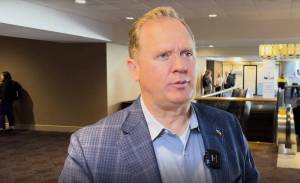Austin mayor turns to data to help meet clean energy commitments

Renewable energy and sustainable technology took center stage Tuesday as Austin, Texas, Mayor Steve Adler emphasized the city’s commitment to have 55 percent renewable energy by 2020, and 75 percent by 2027.
Speaking at the Smart Cities Connect Conference, Adler said the city is investing in green tech projects, such as the city’s sustainability dashboard, to gauge performance through open data, electric cars and renewable energy technologies. After the Trump administration decided to pull the U.S. out of the Paris Agreement — a voluntary set of commitments made by countries to curb carbon emissions — Adler said it is now incumbent on cities to step up where the federal government has stepped down.
“When you think about it, and you look at the terms of what the terms of that international agreement were between nation-states, half of the work that needed to be done was happening at the local level, at the municipal level and at the county level,” Adler said. “As a city here we’ve tried to step up that challenge. We just approved another 450 megawatts in solar energy purchases that more than doubled the number of solar purchases in the state of Texas.”
Data is at the core of that work on sustainability, Adler said, and evidence can be found in the sustainability dashboard the city created in 2016. The platform provides greater transparency to the public on progress toward the city’s sustainability goals. The dashboard shows five years’ worth of open data on more than 40 sustainability performance metrics like water management, energy, air quality and waste. Last year, an overhaul to the city’s portal enabled the open data community and Socrata to develop the dashboard, which acts as a warehouse to store and retrieve sustainability data.
The analytics will help the city follow its community climate plan, which seeks to cut carbon emissions. This plan is intended to reduce the city’s 13.7 million metric tons of emissions down to 11.3 million metric tons by 2020, 8 million tons by 2030 and 4.6 million by 2040.
In conjunction, Adler is a strong proponent of self-driving electric vehicles, an emerging technology that would further lower emissions and assist the city with its objective to lower single passenger vehicle commuting by 20 percent by 2020. In 2015, Austin partnered with Google’s self-driving vehicle division, Waymo, to test the vehicles in real-world conditions.
Austin is also part of a statewide consortium connected to the University of Texas and Texas A&M University that is testing autonomous technologies on a broader scale.
“The focus more and more is coming down to us and what we do, because a smart city at the end of the day is a city … that is able to look on the inside to identify what its real challenges, what its residents need to have a quality of life that they want to have, and then to uniquely craft solutions that enable a city and a community to deal with those challenges,” Adler said.
In addition, the mayor set another goal to make municipal operations emissions-free by 2020. The Adler administration aims to achieve this through a collaborative effort with San Antonio to set up a research program to develop advanced solar technologies, as well as increases in the number of electric vehicles in its city fleets.
Austin Energy’s deputy general manager, Elaina Ball, said Monday that the city is taking advantage of the growth and development gains in renewable energy while confronting some of its difficulties. Now more than ever, she said, renewable energy has become a force to be reckoned with.
“For the longest time, renewable energy in particular had two chief headwinds, the first being price and the second being intermittency, and I can tell you from our own experience at Austin Energy price is no longer a headwind,” Ball said. “We see renewable energy performing on par, and in some cases, outperforming traditional forms of energy.”
One key barrier that remains for renewable energy adoption is the technology’s limited ability to deliver consistent levels of energy, a challenge that will require the development of batteries that can store massive amounts energy. Austin Energy is experimenting with large lithium batteries as a possible solution, but more research is needed, Ball said.
“Intermittency is still a challenge,” she said. “We as a human race have not cracked the nut on how to efficiently and effectively store bulk energy and to me one of the most exciting parts of my job is to work on these big meaty issues.”






